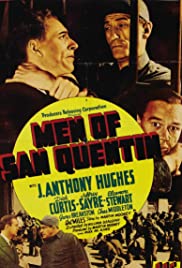
MEN OF SAN QUENTIN
US, 1942, 77 minutes, Black-and-white.
J. Anthony Hughes, Eleanor Stewart, Dick Curtis, Charles Middleton, Jeffrey Sayre, George Breakston, Art Mills.
Directed by William Beaudine.
This is a rather sombre film of 1942, a strong promoter of prison reform, focused on the Californian prison of San Quentin on San Francisco Bay. The making of the film had the collaboration of the warden and staff and prisoners. There is something of a documentary atmosphere with the use of some of the actual San Quentin locations and overviews.
The film was released in 1942, in the aftermath of Pearl Harbor, and there are patriotic speeches at the end of the film promoting the buying of war bonds.
The film highlights the fact that there are 6000 prisoners in San Quentin, that 90% of them are first offenders or second offenders and have the capacity for reform and rehabilitation but are exploited by the remaining 10%. There are riots, murders, the film opening with all the prisoners being in lockdown for one month.
There are criticisms of the authorities, of the warden. When there is an escape attempt and one of the guards is shot, the warden wants to cover it up and primes selected guards and prisoners to testify against the newly arrived warden, Holden, a man of integrity, just married, played by J. Anthony Hughes (with Eleanor Stewart as his sympathetic wife). They are also friendly with a newspaper editor who is eager to do some expose of life in the prison.
The action is complicated by the leader of the escapees, who had murdered the guard as well as a fellow prisoner, caught, brought before a board, confessing to what had happened. In the meantime, the warden puts one of the prisoners as the worker in the home of Holden, to spy on him, but who confesses to the truth and, with the gun that he had hidden, shoots the warden.
Holden comes before an official board, expects to be fired, but they are impressed and offer him the job of the warden – which means that the rest of the film is about his humanitarian efforts to improve life in the prison, turns solitary cells into classrooms, establish courses and study programs, encourage arts and performance. There is still one more attempt at an escape but the prisoners are supporting the warden and the young prisoner that is being used, Louis, is able to alert Holden to what is happening.
The media, newspapers and radio, support the reforms and, in the context of a concert performance, Holden gives final speeches about the aims of reform – and the appeal for buying war bonds.
The following year, there was another film about prison reform, Prison Mutiny.